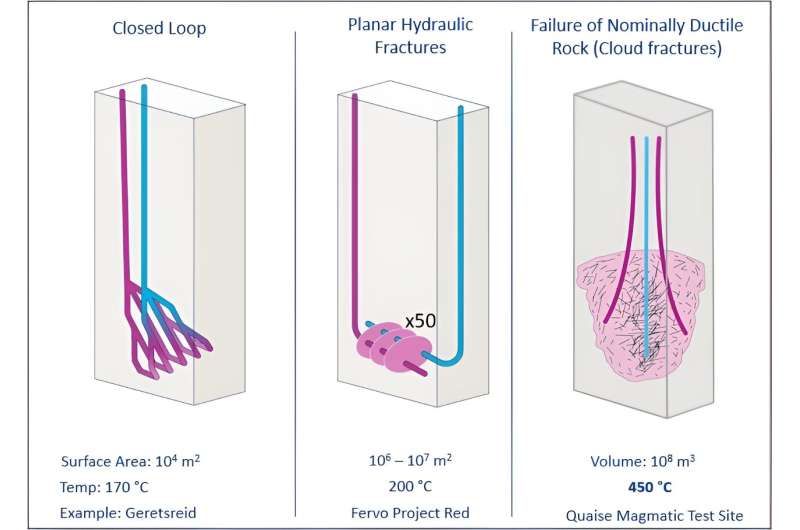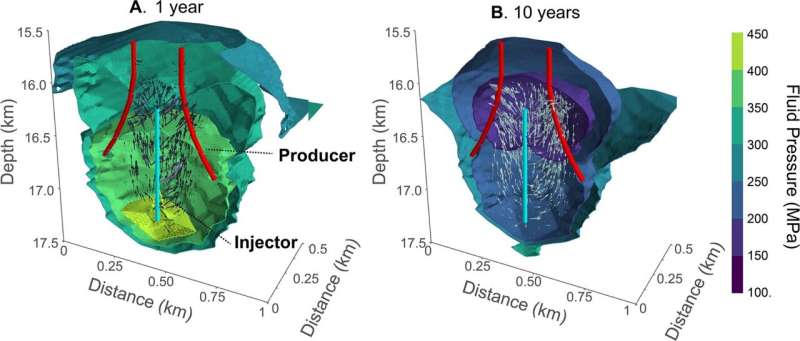This article has been reviewed according to Science X's editorial process and policies. Editors have highlighted the following attributes while ensuring the content's credibility:
fact-checked
proofread
Geothermal model gives key insights into extracting renewable energy from superhot, super deep rock

Geothermal energy from the superhot rock miles below our feet has the potential to become a major player in the energy transition, but first we need to develop ways to not only access those rocks, but also extract their heat. Now a computer model sheds light on the latter, describing for the first time what happens when rock at those depths and temperatures is exposed to fluids that can eventually transfer the rocks' heat to the surface.
Essentially, the model shows the formation of microscopic cracks creating a dense "cloud of permeability" throughout the affected rock. This is in contrast to the much larger and fewer macroscopic fractures induced by the engineered geothermal systems (EGS) in use today, which operate closer to the surface and at much lower temperatures.
Simulations using the model, which was reported in the journal Geothermal Energy, "confirm that a superhot system can deliver five to ten times more power than typically produced today from EGS systems for up to two decades," says Trenton Cladouhos, Vice President of Geothermal Resource Development at Quaise Energy.
Cladouhos described the model and the importance of superhot rock geothermal systems in general on May 21 at the Geothermal Transition Summit, North America. His talk was titled, "Superhot Rock EGS: Methods, Challenges, and Pathways Forward."
Authors are Samuel Scott of the Institute of Earth Sciences at the University of Iceland, Alina Yapparova of the Institute of Geochemistry and Petrology at ETH Zurich, Philipp Weis of the GFZ Potsdam German Research Center for Geosciences, and Matthew Houde, co-founder at Quaise.
Superhot rock energy
Cladouhos' remarks focused on the challenges associated with extracting heat from far under the ground where superhot rocks sit at temperatures of more than 707 degrees Fahrenheit (375oC). Water seeping through those areas would become supercritical. This steam-like phase carries 3–4 times more energy than regular hot water, and when piped to turbines on the surface converts 2–3 times more efficiently into electricity.
Recovery of just 2% of the thermal energy stored in hot rock 3 to 10 km [2 to 6 miles] below the continental U.S. is equivalent to 2,000 times the primary U.S. energy consumption annually, according to "The Future of Geothermal Energy," a 2006 MIT-led study on the potential for geothermal energy within the United States.
One key problem to accessing that energy is simply getting there. The drills used by the oil and gas industries aren't designed to withstand the extreme temperatures and pressures miles down, where the mother lode of geothermal energy lies. That's why Quaise is working on a completely new way to drill using millimeter wave energy (cousins to the microwaves many of us cook with) that can literally melt and vaporize rock.
But drilling into superhot rock is only the first challenge. Extracting the heat is a puzzle that's at least as difficult as getting there, Cladouhos says.

Researchers around the world are working on engineered geothermal systems, essentially underground radiators or heat exchangers, that aim to do just that. There are a variety of approaches being developed—and used in the field—by companies such as Eavor and Fervo Energy, but none have been demonstrated at temperatures over about 200 oC.
"If we really want geothermal to be a game changer, we have to operate at superhot temperatures, or over 375oC," Cladouhos says.
But little is known about what happens when superhot rock at great depth is exposed to cold water pumped down at high pressures.
A new understanding
Currently there are three general concepts for how to extract the geothermal energy that is closer to the surface, or down to about two miles. These include closed-loop systems relying on a series of horizontal underground pipes that connect two wells.
Water pumped down one well travels through these pipes, picks up the energy from the rock, then travels back up to the surface via the second well. This is the approach used by Eavor. Another concept involves connecting two horizontal wells with a system of hundreds of manmade fractures. That is the approach used by Fervo Energy.
The model Cladouhos described at the Geothermal Transition Summit—and a week later at the Clean Air Task Force's workshop Bridging the Gaps: Advancing Superhot Rock Energy in Iceland—represents a new concept for tapping geothermal energy, focusing on what could happen when cold water is injected under superhot, super deep conditions.
Enter the microcracks. "The idea is that you're connecting wells via a large 'cloud' of permeability rather than specific, much larger fractures," Cladouhos says. "So it's more of a diffuse connection rather than a localized connection."
The model is based on what we know about alteration of formations under these extreme conditions. Think of the huge open pits of orange rocks from which copper and gold ores are extracted. It is also informed by tests in Japan that have shown microcracks forming under analogous conditions in the lab. The latter work was reported last year in a Geothermal Energy paper.
What's next
Cladouhos notes that the model, which Scott and colleagues continue to refine, "will help guide future tests of superhot rock in the field." Quaise aims to do just that over the next year or two at a site like Newberry volcano in central Oregon where superhot conditions can be reached at shallower depths.
He concludes, "This is a model. We don't know if the permeability due to microcracking will be enough to connect two wells in the real world. Now we need to test it and other concepts of fracturing superhot rock in the field. In the end, a hybrid approach involving planar fractures, natural fractures, and microfractures may be needed."
More information: Samuel Scott et al, Hydrological constraints on the potential of enhanced geothermal systems in the ductile crust, Geothermal Energy (2024). DOI: 10.1186/s40517-024-00288-4

















